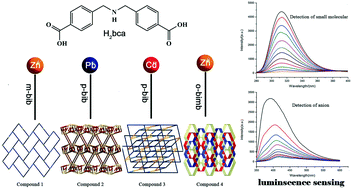Construction of functional coordination polymers derived from designed flexible bis(4-carboxybenzyl)amine†
Abstract
Four coordination polymers (CPs), [Zn2(H2BCA)2(o-bimb)2(H2O)2]n (1), {[Pb(H2BCA)(p-bib)0.5]·H2O}n (2), {[Cd2(H2BCA)2(p-bib)2]·(H2O)3}n (3) and {[Zn(H2BCA)(m-bib)]·H2O}n (4), have been derived from the designed flexible bis(4-carboxybenzyl)amine (H2BCA) with bis(imidazole) linkers (p-bib = 1,1′-benzene-1,4-diylbis(1H-imidazole), m-bib = 1,3-bis(1-imidazoly)benzene, and o-bimb = 1,2-bis(imidazol-1-ylmethyl) benzene). X-ray single crystal diffraction analyses reveal that complex 1 is a 3D supramolecular structure composed of 2D 3-connected hcb layers via hydrogen contacts. Complex 2 exhibits a 3D 2-nodal (4,5)-connected {44.62}{44.66}-tcs net. Complex 3 shows a novel 2-nodal 3D (4,5,5)-connected net with the point symbol {4.66.83}2{42.62.82}. Complex 4 displays a 3D 3-fold interpenetrating 3-connected {103} ThSi2 net. Structural comparison reveals that the central ions as well as the auxiliary ligand play critical roles in determining the coordination modes of H2BCA and the final structures. In addition, the luminescence measurements of two zinc-containing compounds (1 and 4) have been discussed and show excellent selectivity and sensitivity in detecting acetone molecules and Cr2O72−/CrO42− anions in aqueous solution.



 Please wait while we load your content...
Please wait while we load your content...